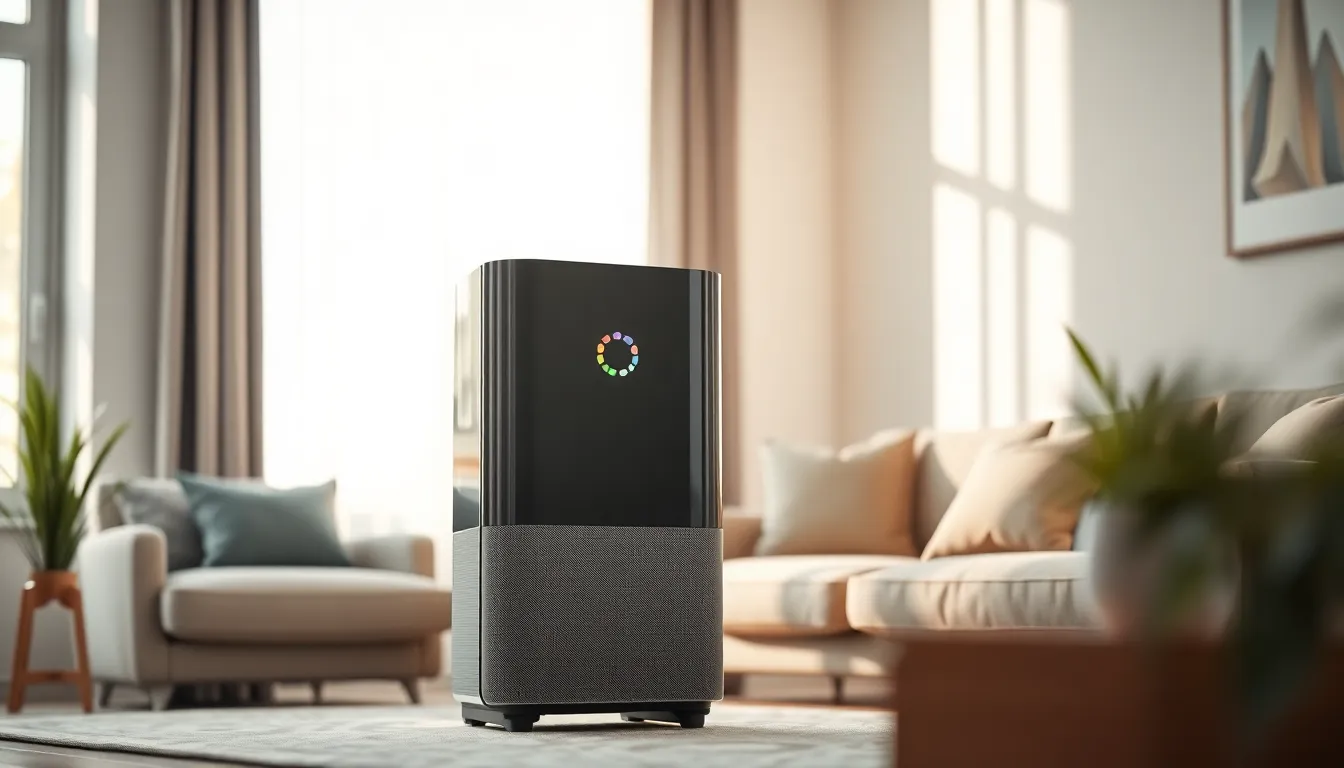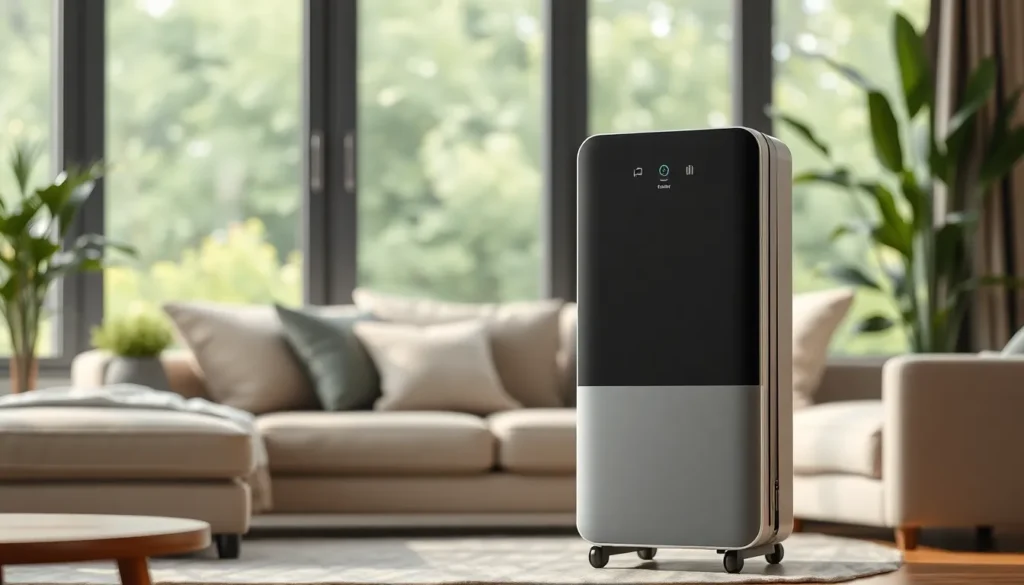In a world where air quality often rivals a bad reality show, smart air purifiers are stepping in as the unsung heroes. These nifty gadgets don’t just filter out dust and pet dander; they also come packed with features that make them as smart as your smartphone. Imagine breathing in fresh air while your purifier works harder than your over-caffeinated coworker to keep your home healthy.
With sensors that detect pollutants and app connectivity that lets you control it from anywhere, a smart air purifier is like having a personal air quality assistant. It’s time to kick those allergens to the curb and embrace a breath of fresh air—literally! So, if you’re ready to transform your space into a sanctuary of clean, crisp air, let’s dive into the world of smart air purifiers and discover how they can elevate your indoor environment.
Table of Contents
ToggleOverview of Smart Air Purifiers
Smart air purifiers provide advanced filtration systems that effectively reduce various indoor pollutants. Equipped with sensors, these devices detect particulate matter, volatile organic compounds, and other harmful substances in the air. Users benefit from real-time air quality monitoring through connected apps, allowing them to understand their environment at a glance.
Many models feature multiple filtration stages, including pre-filters, HEPA filters, and activated carbon filters. HEPA filters trap 99.97% of particles as small as 0.3 microns, ensuring comprehensive air purification. Activated carbon filters effectively remove odors and gases, enhancing overall air quality.
Connectivity options enhance user experience. Smart air purifiers integrate seamlessly with home automation systems, enabling voice control through devices like Amazon Alexa or Google Assistant. Users can schedule operation times or adjust settings remotely, promoting energy efficiency and convenience.
Some units also utilize advanced technologies like UV-C light to further eliminate bacteria and viruses. This added protection contributes to healthier indoor air, especially in homes with allergy sufferers or those vulnerable to respiratory issues.
Smart air purifiers offer a range of designs to fit any living space, from compact models ideal for bedrooms to larger units suited for open areas. Noise levels vary, with many units operating quietly, ensuring minimal disruption during use.
Overall, smart air purifiers combine functionality and technology to create an essential tool for maintaining a healthier indoor environment. These devices adapt to individual needs while offering enhanced features that distinguish them from traditional air purifiers.
Features of Smart Air Purifiers

Smart air purifiers come packed with various features that enhance their effectiveness and user experience. They utilize innovative technology to monitor and improve indoor air quality.
Smart Sensors and Automation
Smart sensors continually assess air quality. These sensors detect pollutants and automatically adjust the purifier’s settings accordingly. Users benefit from real-time data, ensuring optimal performance. Automation enables the device to operate efficiently without constant manual intervention. Many smart air purifiers also include air quality indicators, providing visual feedback through color-coded lights. Users can trust that their air remains clean and safe to breathe thanks to these advanced functions.
Mobile App Integration
Mobile app integration takes convenience to the next level. Users can control their smart air purifiers remotely through dedicated mobile applications. These apps offer features such as scheduling, allowing users to set specific purification times. Remote monitoring enables users to check air quality levels without being at home. Notifications can alert users about filter replacement or air quality changes. Seamless connectivity to smart home systems enhances overall functionality, making indoor air quality management effortless.
Benefits of Using Smart Air Purifiers
Smart air purifiers offer significant advantages that enhance indoor air quality and user experience. Their advanced design incorporates various features that contribute to overall health.
Improved Air Quality
Smart air purifiers continuously monitor indoor air pollutants. Sensors detect dust, allergens, and other contaminants, adjusting filtration accordingly for optimal performance. Users notice improvements in air quality, as these devices can capture 99.97% of particles as small as 0.3 microns. Many models utilize multiple filtration stages, including HEPA and activated carbon filters, to eliminate odors and harmful gases. Real-time air quality indicators provide feedback through visual signals, reassuring users about air cleanliness at all times.
Energy Efficiency
These devices promote energy efficiency through intelligent operation. Smart air purifiers adjust their settings based on environmental needs, reducing energy consumption. Many models include programmable features allowing users to schedule operation periods during off-peak hours. This efficiency not only lowers energy bills but also supports sustainability efforts. Voice control and app integration enhance convenience, ensuring users can manage air purification easily, even when away from home. Lower energy use contributes positively to both environmental and financial savings.
Popular Smart Air Purifier Models
Smart air purifiers come in various models, each offering unique features. Two popular options include Model A and Model B, which deliver superior performance in air purification.
Model A Review
Model A stands out for its advanced filtration system, effectively capturing 99.97% of airborne particles. This unit features a three-stage filtration process, including a pre-filter, a HEPA filter, and activated carbon. Users appreciate its app connectivity, allowing remote operation and real-time air quality monitoring. Color-coded air quality indicators provide immediate feedback, ensuring users can assess their environment quickly. Its sleek design fits seamlessly into any room. The unit’s quiet operation makes it suitable for bedrooms or nurseries, enhancing user comfort.
Model B Review
Model B excels with its smart sensor technology, enabling automatic adjustments based on detected air quality levels. This purifier incorporates a multi-stage filter system that includes a HEPA filter and a UV-C light for added disinfection. High-efficiency airflow ensures rapid purification, making it ideal for larger spaces. Users benefit from scheduling options via its mobile app, which promotes energy conservation. Additionally, the real-time analytics feature helps track indoor air quality trends over time. With several fan speeds and a compact design, Model B adapts to various user needs while maintaining aesthetic appeal.
Considerations When Choosing a Smart Air Purifier
When selecting a smart air purifier, assess your specific air quality needs. Consider the size of the space where the purifier will operate, as models vary in coverage area. Smaller units typically suit bedrooms or offices, while larger options fit open living spaces.
Evaluate the filtration system included in each model. Many smart air purifiers feature multi-stage filtration, combining pre-filters, HEPA filters, and activated carbon filters. Look for options that trap 99.97% of particles down to 0.3 microns for effective air purification.
Examine connectivity features that enhance usability. Models with app integration allow users to control settings remotely and monitor air quality in real-time. Voice control compatibility adds convenience by enabling hands-free operation.
Prioritize smart sensors for automatic adjustments based on air quality. This feature ensures optimal performance without manual intervention, helping maintain a consistently healthy environment. Units with visual air quality indicators provide immediate feedback, making it easier for users to track changes in air purity.
Affordability matters. Review the price range of different models while considering their additional features. Some purifiers may offer advanced technology like UV-C light, which enhances the elimination of bacteria and viruses, adding value for health-conscious consumers.
Additionally, noise level can be a crucial factor, especially in quiet spaces like bedrooms. Opt for models designed for quiet operation to ensure minimal disruption during sleep or relaxation.
Finally, assess maintenance requirements such as filter replacement frequency. Models with longer-lasting filters reduce hassle and potentially lower long-term costs, making them a wise investment in indoor air quality management.
Smart air purifiers are transforming the way individuals manage their indoor air quality. With advanced technology and user-friendly features they provide a level of convenience and efficiency that traditional purifiers simply can’t match. These devices not only enhance air quality but also promote healthier living environments by continuously monitoring pollutants and adjusting settings automatically.
As consumers become more aware of the importance of clean air choosing the right smart air purifier can significantly impact their overall well-being. Whether it’s for a bedroom or a larger living space the right model can make a noticeable difference. Investing in a smart air purifier is a proactive step towards ensuring cleaner air and a healthier lifestyle.






